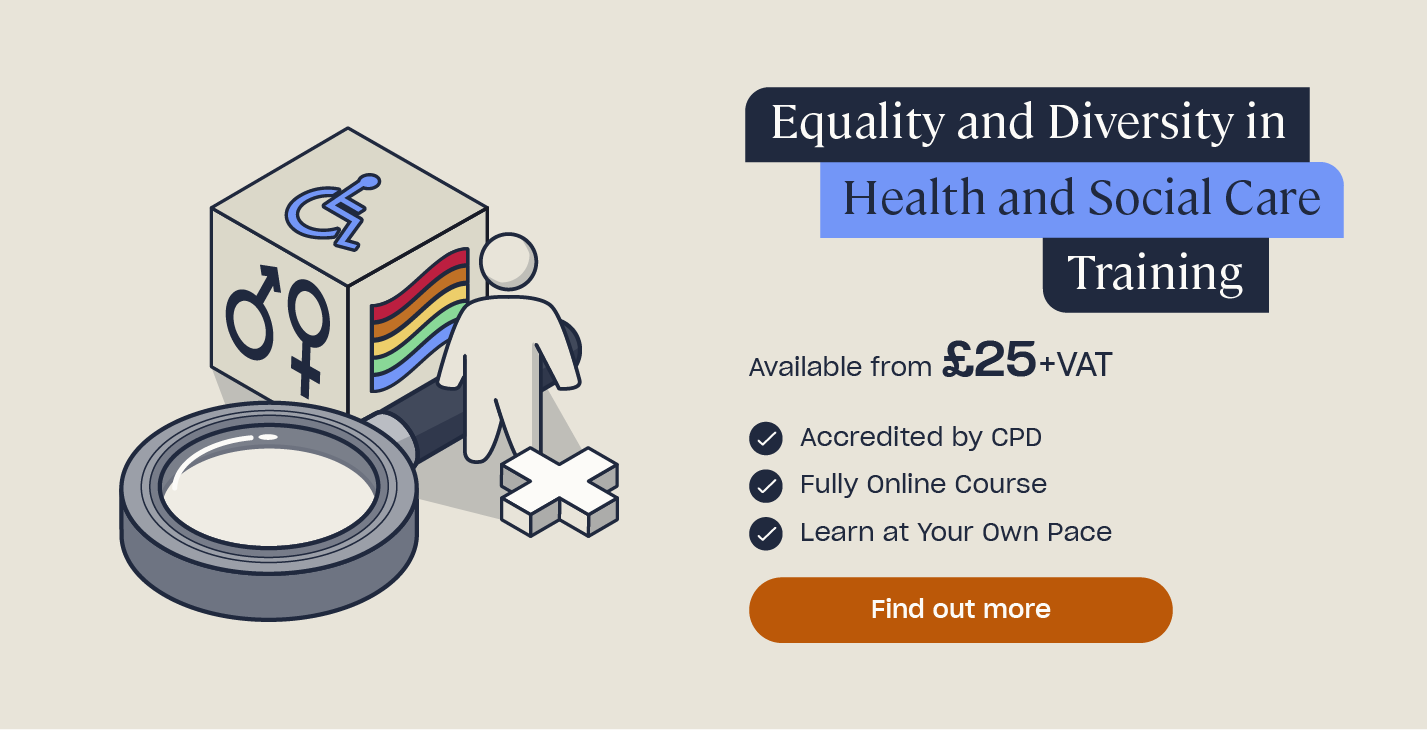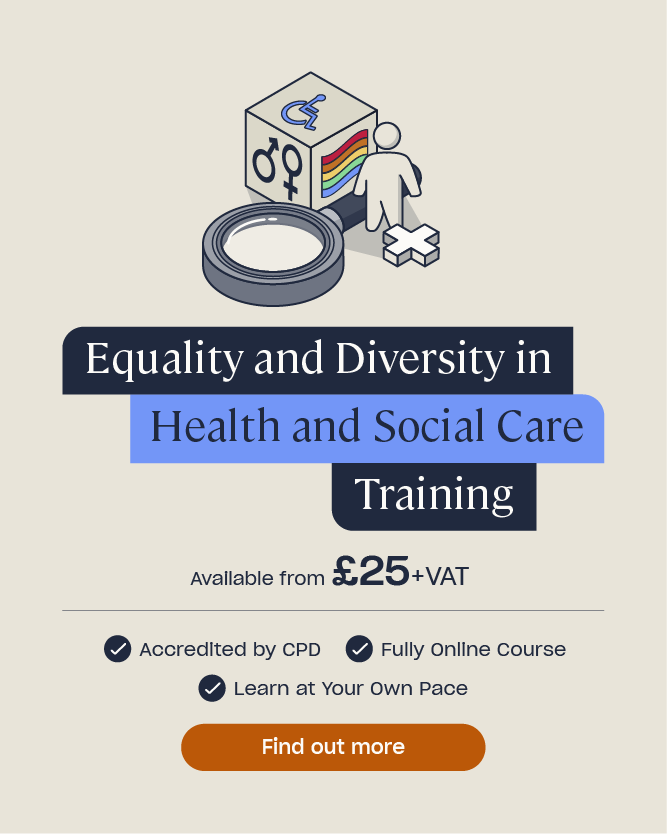Defining the Different Types of Discrimination in Health and Social Care
Of all the jobs that involve interacting with people, working in health and social care is likely one of the most demanding, as the very wellbeing of individuals is entrusted to you: the caregiver. But it can also be one of the most rewarding, especially if you treat the people you work with and your service users right.
By providing each and every patient with person-centred care, their quality of life will be greatly enhanced during what could otherwise be a difficult time for them. Likewise, being supportive and amiable towards colleagues in your healthcare environment will infuse them with feelings of positivity and the motivation to also treat others well.
To effectively do so, you need to understand what types of discrimination you should be preventing.
Why is Preventing Discrimination Important?
As you’ll no doubt know as someone who is dedicating their life to upholding people’s healthcare and wellbeing, the emotional needs of a person are equally if not more important in some cases than the physical.
Try to comprehend the idea of being mistreated or not suitably accommodated by someone devoted to delivering care: it’s ironic. Being discriminated against by a healthcare professional is detrimental to a person’s emotional needs and denies them adequate treatment, which is as much a disservice as a chef sending out chicken to guests raw.
And yet discrimination in the healthcare industry is widespread – targeted at both service users and fellow caregivers – ranging from gender inequality, through ageism and racism, to the mistreatment of transgender people.
Want to Learn More?
Our Equality and Diversity in Health and Social Care Training explains what the Equality Act 2010 requires of health and social care providers, what is meant by discrimination, harassment and victimisation, and how you can improve your own attitude towards equality and diversity.
What are the Different Types of Discrimination?
There are 4 different kinds of discrimination from which anyone with one or more of the protected characteristics is safeguarded:
- Direct discrimination
- Indirect discrimination
- Associative discrimination
- Perceptive discrimination
There are also specific types that could fall under these categories, such as:
- Multiple discrimination
- Harassment and sexual harassment
- Third party harassment
- Victimisation
Click on the drop downs below for more information on these different types of discrimination in health and social care.
Who could be subject to discrimination? 
Anyone could be a victim of unlawful mistreatment because everyone can identify with at least one of the protected characteristics. Under the Equality Act 2010, it is unlawful to subject someone to mistreatment because of their:
- Age.
- Disability.
- Sex.
- Sexual orientation.
- Race.
- Religion or belief.
- Gender reassignment.
- Marriage or civil partnership.
- Pregnancy and maternity.
Direct Discrimination 
This is the type of discrimination most people will face. If a person is intentionally treated less favourably purely based on the fact that they possess one or more of their protected characteristics, then it is direct discrimination.
Examples of direct discrimination include:
- Denying a service user treatment because they are ‘too old’.
- Refusing an employee time off work for a religious event.
- Denying a same-sex couple access to healthcare.
- Not allowing an employee access to work opportunities because they are ‘too young’.
- Not hiring a person because of their disability or not suitably accommodating them.
There are numerous real life cases about direct discrimination in the healthcare industry – scroll to the bottom of this article to read three diverse examples of this.
Indirect Discrimination 
When there is a practice, condition, policy, or rule that applies to everyone but inadvertently puts people with one or more of the protected characteristics at a disadvantage, it is considered indirect discrimination.

This will often be unintentional; the employer who made the decision or has plans for a new policy may think that by applying one general rule, everyone is being treated equally. It could be due to a lack of awareness, poor attitudes towards equality and diversity, or unconscious bias.
Examples of indirect discrimination include:
- Having a policy where all female and male patients must be given care by someone of the same gender – some people may prefer certain carers of the opposite gender or transgender people may want to be seen by the gender they identify with.
- Having a policy where all staff are required to work on Sundays – this may disadvantage Christians that attend Church.
- Serving lunch to service users at a certain time each day without flexibility – this may not be accommodating of people who are fasting as part of their religious beliefs.
- Identification systems or dress codes – e.g. disadvantaging Muslims who wear head scarves.
Often, people’s background, culture, or personal experiences lead to them adopting certain attitudes or perceptions without even realising it. It’s important to keep yours in check so to prevent indirect discrimination.
Remember: a person from another religion’s view of life will differ greatly from your own, and you must be accepting of their ideologies.
Associative Discrimination
If someone is directly discriminated against because they associate with someone who has a protected characteristic – whether it be a parent, child, partner, or friend – it is considered associative discrimination. Even though the discriminatory behaviour isn’t directly targeted at the person with the protected characteristic, it is still intolerant and unlawful to mistreat someone else because of it.
Examples of associative discrimination include:
- An employee being fired because they are taking time off to care for their disabled child.
- Making fun of a colleague because they care for old people.
- Not wanting to care for a patient because they are married to an Asian woman.
Perceptive Discrimination 
If someone is mistreated or denied equal opportunity because of a protected characteristic that the person discriminating thinks they have, it is considered perceptive discrimination. It is discrimination regardless of whether or not the person actually possesses the characteristic.
Examples of perceptive discrimination include:
- A carer being condescending towards a service user because they think they have a learning disability.
- A colleague being teased or bullied for ‘being gay’ when in reality they are heterosexual.
- A health centre receptionist making inappropriate comments towards people they assume are Muslim.
Multiple discrimination 
When a person is discriminated against for numerous protected characteristics, it is considered multiple discrimination. For instance, a woman who is giving birth at a hospital may be given less attention than other pregnant women who are of British nationality because she is gay and because she is of foreign origin.
It may even fall under more than one type of discrimination. For example: directly discriminating against a caregiver because of their age and gender and discriminating by perception by assuming they follow a certain religion and treating them poorly because of it.
Harassment and Sexual Harassment 
The definition of harassment is simple: unwanted conduct related to a protected characteristic, which violates an individual’s dignity or creates an intimidating, hostile, degrading, humiliating, or offensive environment for that individual.
Examples of harassment include:
- Employees picking on a Muslim colleague for wearing a headscarf.
- A receptionist acting uncaring towards and being impatient with elderly service users.
- A doctor making unwanted sexual advances or remarks about a nurse of either the same or opposite gender.
- Talking down to a colleague who is going through gender reassignment.
- Making inappropriate comments about a service user’s body when they undress for reasons relating to their care or treatment.
Even if the harasser is ‘just having fun’ or ‘wasn’t being serious’, it is still harassment nonetheless. Employees are able to report instances of harassment that they witness even if it wasn’t directed at them, and shouldn’t hesitate to do so.
Sexual harassment is a particularly prominent issue, especially in the healthcare profession for female nurses and doctors (although it is not exclusive to females). Sexual harassment doesn’t necessarily have to involve any physical behaviour either; it could be verbal, through texts, or gestures as well. Visit the case study section below for an example of sexual harassment in the healthcare industry.
Third Party Harassment
This refers to individuals being harassed by anyone outside of the company. In a healthcare setting, where potentially hundreds of non-employees will be present on a daily basis, healthcare staff may be at a particularly high risk of third party harassment from service users. Preventing this is equally important; caregivers can only deliver their services effectively if they are free of harassment.
The sexual harassment case study in the section entitled ‘Case Studies’ below is also an example of third party harassment.
Victimisation 
If a person is treated unfavourably or disadvantaged because they have made or assisted someone in making a complaint about discriminatory behaviour, this is known as victimisation. As mentioned above, you have every right to raise your concerns if you experience or observe discriminatory behaviour in the workplace, and being treated poorly for doing so is unlawful.
Examples of victimisation include:
- Being verbally abused by a colleague because you helped make a complaint about a nurse being sexually harassed.
- Being fired because you made a complaint about your boss telling you not to offer support to transgender service users.
- Being demoted because you raised concerns about work shifts which don’t accommodate people with religious holidays.
Any instance of discrimination can and should be reported. Employers have a legal duty to take action and investigate the matter as soon as it comes to their knowledge that discrimination or harassment is taking place in their organisation – whether it be from an employee or a third party.

If you or someone you know – whether it’s a colleague or service user – has been subject to discrimination, please contact the government’s Equality Advisory Support Service (EASS).
For more information about discrimination, visit the Citizens Advice website.
Statistics on Discrimination in Healthcare 
- According to a Mencap survey, health professionals reported discrimination against those with learning disabilities. From a poll of 1,000+ people, 46% of doctors and 37% of nurses stated they believed or witnessed people with learning disabilities receive poorer NHS care than others.
- In a Health and Retirement study, it was identified that, from a nationally-represented sample of 6,017 service users aged above 50, 1 in 5 reported experiencing discrimination in their healthcare setting. One of the most common forms reported was age discrimination.
- Research carried out by The King’s Fund on behalf of the NHS reported that – out of 255,150 staff members from 284 organisations that took a staff survey – 12% stated they experienced some form of discrimination in 2014, with ethnic background being the most prominent reason for being discriminated against (4.3%).
Case Studies 
Ageism towards Elderly Woman with Leaky Valve
An elderly woman named Violet Simpson, 84, was receiving treatment for angina over the course of two years. Prior to having an operation for a bunion on her big toe, she was sent for a heart scan. It was then discovered that the issue was in fact not angina, but a leaky valve.
However, when requesting for it to be treated, Violet was disregarded by doctors. She said “I asked if I could have this fixed. The attitude from doctors was: What are you bothered about, at your age?”
She eventually managed to get an appointment; “I stuck to my guns and said I wanted this job done.” But she said “The whole experience made me feel pushed aside.” This was a clear case of age discrimination.
Same-Sex Couple’s Baby Refused Treatment by Paediatrician
In 2014, paediatrician Dr. Vesna Roi refused to care for a same-sex couple’s baby because of her anti-gay religious beliefs. After “much prayer” she’d decided she couldn’t treat their baby because they are lesbians. The couple had to instead be seen by a different paediatrician even though they had handpicked Dr. Roi out of all the ones they had interviewed. Dr. Roi sent them a letter of apology 4 months later, although she didn’t retract her refusal to care for their baby.

Dr. Roi made it clear that she was very strongly invested in delivering wholesome care; she stated “I love my families, my patients. I love my kids, and I have become very close with all my patients.” However, regardless of whether it was with ill-intent or not, her refusal was a clear case of direct discrimination against the protected characteristic of sexual orientation.
Female Receptionist Subject to Sexual Remarks in Hospital Environment
Between April and December 2009 and between June and September 2010, a female receptionist at a hospital was repeatedly sexually harassed by the same male patient. He made unwanted sexual comments both in person when visiting the facility and over the telephone when calling in.
Remarks included suggesting that she ‘run away’ with him, that he was ‘visualising her naked’, and inviting her to have sex with him. Despite the complaints the receptionist made to her supervisor, no action was taken to stop the harassment. This is a clear example of third party sexual harassment.
Whether it be a colleague or a service user, whether they’re young or old, or whether they’re the same nationality as you or of a different one entirely, everyone deserves to be treated well and have their needs fully accommodated.
Do what you can to prevent or eliminate any possibility of discrimination occurring. Do your best to dispose of any discriminatory attitudes you may have and work together with others in your healthcare team to ensure everyone has equal access to treatment and care.
Further Resources:
- Health & Social Care Complaint Procedure Guidance
- How To: Promoting Equality & Diversity in Health & Social Care
- How To Promote Equality & Diversity in Health & Social Care
- What are Inequalities in Health and Social Care?
- How to Promote Equality, Diversity and Inclusion in the Workplace
- Equality and Diversity in Health and Social Care Training







